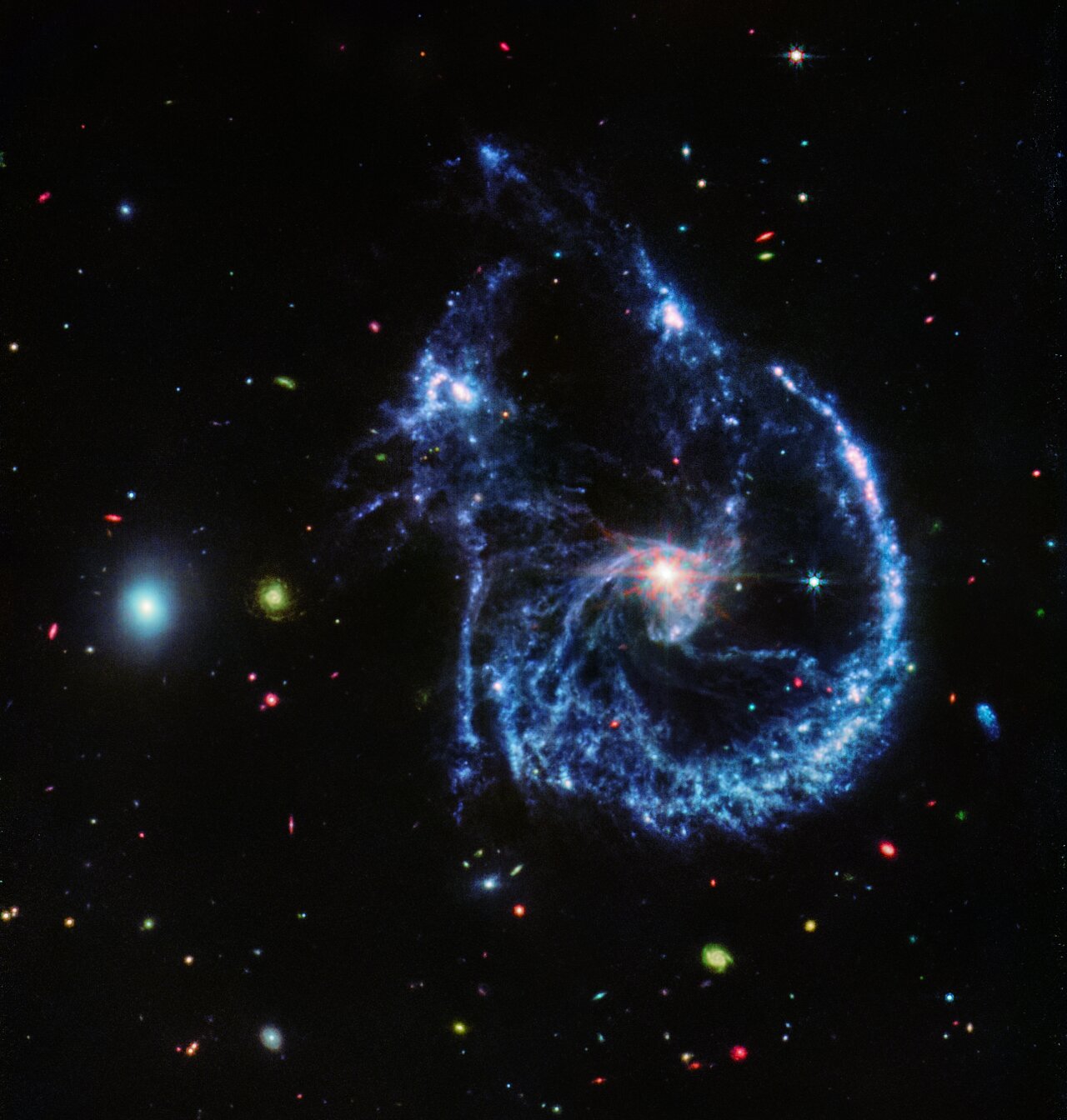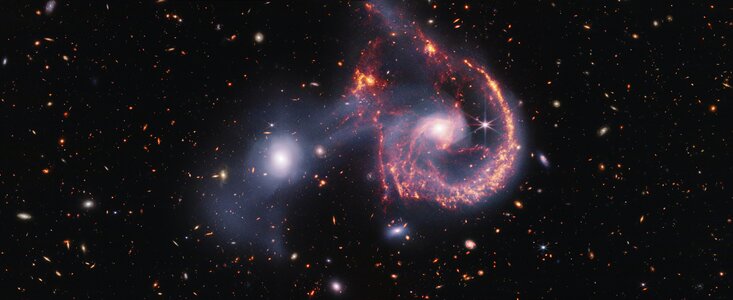An interaction between an elliptical galaxy and a larger spiral galaxy, collectively known as Arp 107, seems to have given the spiral a happier outlook thanks to the two bright ‘eyes’ and the wide semicircular ‘smile’ that have resulted. This image is a composite, combining observations from Webb’s MIRI (Mid-InfraRed Instrument) and NIRCam (Near-InfraRed Camera).
NIRCam highlights the stars within both galaxies and reveals the connection between them: a transparent, white bridge of stars pulled from both galaxies during their passage. MIRI data, represented in orange-red, show star-forming regions and dust that is composed of soot-like organic molecules known as polycyclic aromatic hydrocarbons. MIRI also provides a snapshot of the bright nucleus of the large spiral, home to a supermassive black hole.
The spiral galaxy is classified as a Seyfert galaxy, one of the two largest groups of active galaxies, along with galaxies that host quasars. Seyfert galaxies aren’t as luminous or as distant as quasars, so they are better places to study similar phenomena in lower-energy light, like infrared.
This region is much like the Cartwheel Galaxy, one of the first interacting galaxies that Webb observed. Arp 107 may have turned out very similar in appearance to the Cartwheel, but since the smaller elliptical galaxy had an off-centre collision instead of a direct hit, the spiral galaxy got away with only its spiral arms being disturbed.
The collision isn’t as bad as it sounds. Although there was much star formation occurring before, collisions between galaxies can compress gas, improving the conditions needed for more stars to form. On the other hand, as Webb reveals, collisions also disperse a lot of gas, potentially depriving new stars of the material they need to form.
Webb has captured these galaxies in the process of merging, which will take hundreds of millions of years. As the two galaxies rebuild after the chaos of their collision, Arp 107 may lose its smile, but it will inevitably turn into something just as interesting for future astronomers to study.
Arp 107 is located 465 million light-years from Earth in the constellation Leo Minor.
Arp 107 composite image (NIRCam + MIRI)

This composite image of Arp 107, created with data from the James Webb Space Telescope’s NIRCam (Near-InfraRed Camera) and MIRI (Mid-InfraRed Instrument), reveals a wealth of information about the star formation taking place in these two galaxies and how they collided hundreds of million years ago.
The near-infrared data, shown in white, show older stars, which shine brightly in both galaxies, as well as the tenuous gas bridge that runs between them. The vibrant background galaxies are also brightly illuminated at these wavelengths.
On the other hand, MIRI data show the young stars and star-forming regions in vibrant orange and red. Our view in the mid-infrared provides the best view of the collision point, given the noticeable gap at the top of the spiral galaxy. This collision not only began a new bout of star formation in the region, but also produced an endearing smile.
[Image description: A pair of interacting galaxies. The larger of the two galaxies is slightly right of centre, and is composed of a hazy, bright, white centre and a ring of gaseous filaments, which are different shades of red and orange. Toward the bottom left and bottom right of the ring are filaments of gas spiralling inward toward the core. At the top left of the ring is a noticeable gap, bordered by two large, orange pockets of dust and gas. The smaller galaxy is made of hazy and white gas and dust, which become more diffuse further away from its centre. To this galaxy’s bottom left, there is a smaller, more diffuse gas cloud that wafts outward toward the edges of the image. Many red, orange, and white galaxies are spread throughout, with some being hazier in appearance and others having more defined spiral patterns.]
Credit:
NASA, ESA, CSA, STScI
Arp 107 MIRI image

This image of Arp 107, obtained by Webb’s MIRI (Mid-InfraRed Instrument), reveals the supermassive black hole that lies in the centre of the large spiral galaxy to the right, as evidenced by the small, bright central ‘core’. This bright core, where the black hole is pulling much of the dust into lanes, also features Webb’s characteristic diffraction spikes, caused by the light that it emits interacting with the structure of the telescope itself.
Perhaps the defining feature of the region, which MIRI reveals, are the millions of young stars that are forming, highlighted in blue. These stars are surrounded by dusty silicates and soot-like molecules known as polycyclic aromatic hydrocarbons. The small elliptical galaxy to the left, which has already completed much of its star formation, is composed of many of these organic molecules.
[Image description: A pair of interacting galaxies. The larger of the two galaxies is slightly right of centre, and is composed of a bright, white centre and a ring of blue, gaseous filaments. The centre of this galaxy shows Webb’s eight-pronged diffraction pattern. There are three filaments of gas and dust moving from the ring toward the centre. At the top left of the ring is a noticeable gap, bordered by two large, blue pockets of dust and gas. The smaller galaxy is made of hazy, light blue gas and dust. Many red, green, blue, and yellow galaxies are spread throughout, with some being hazier in composition and others having more defined spiral patterns.]
Credit:
NASA, ESA, CSA, STScI
Arp 107 compass image

The north and east compass arrows show the orientation of the image on the sky. Note that the relationship between north and east on the sky (as seen from below) is flipped relative to the direction arrows on a map of the ground (as seen from above).
The scale bar is labelled in light-years, which is the distance that light travels in one Earth-year. (It takes 75 000 years for light to travel a distance equal to the length of the bar.) One light-year is equal to about 5.88 trillion miles or 9.46 trillion kilometres. The field of view shown in this image is approximately 450 000 light-years across.
This image shows invisible near-infrared and mid-infrared wavelengths of light that have been translated into visible-light colours. The colour key shows which NIRCam and MIRI filters were used when collecting the light. The colour of each filter name is the visible light colour used to represent the infrared light that passes through that filter.
[Image description: Alt Text: A pair of interacting galaxies. At the bottom left are compass arrows indicating the orientation of the image on the sky. The north arrow points in the 10 o’clock direction. The east arrow points toward 6 o’clock. At the lower right is a scale bar labelled in light-years. The length of the scale bar is one-sixth the total width of the image. Below the image is a colour key showing which NIRCam filters were used to create the image and which visible-light colour is assigned to each filter. From left to right, the NIRCam filters are: F090W is blue; F150W is blue; F200W is green; F277W is green; F356W is red; and F444W is red. From left to right, the MIRI filters are: F770W is yellow; F1000W is orange; and F1500W is red.]
Credit:
NASA, ESA, CSA, STScI
VIDEOS
Pan video: Arp 107
This composite image of Arp 107, created with data from the James Webb Space Telescope’s NIRCam (Near-InfraRed Camera) and MIRI (Mid-InfraRed Instrument), reveals a wealth of information about the star formation taking place in these two galaxies and how they collided hundreds of million years ago.
The near-infrared data, shown in white, show older stars, which shine brightly in both galaxies, as well as the tenuous gas bridge that runs between them. The vibrant background galaxies are also brightly illuminated at these wavelengths.
On the other hand, MIRI data show the young stars and star-forming regions in vibrant orange and red. Our view in the mid-infrared provides the best view of the collision point, given the noticeable gap at the top of the spiral galaxy. This collision not only began a new bout of star formation in the region, but also produced an endearing smile.
Credit:
NASA, ESA, CSA, STScI, N. Bartmann (ESA/Webb)
Music: Noizefield - Expect the Unexpected
Fuente: ESA/Hubble/Webb Information Centre






Comentarios